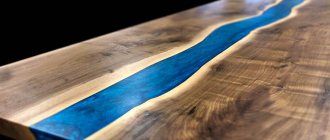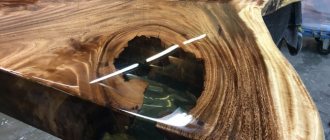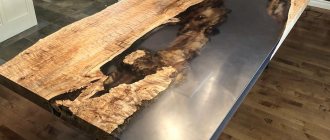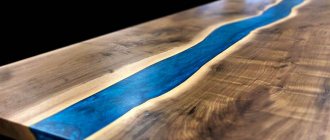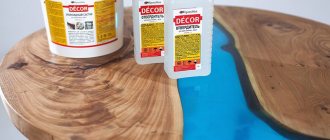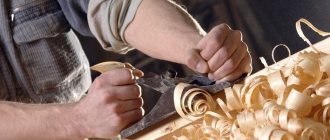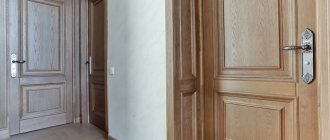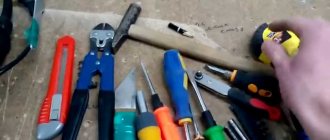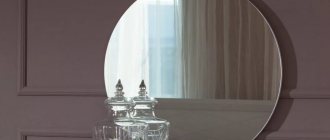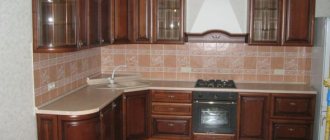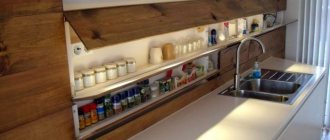Advantages and disadvantages of slab tables
Slab furniture in combination with epoxy resin has many advantages, including:
- Wear resistance and durability;
- External attractiveness;
- Resistance to mechanical damage;
- Moisture resistance;
- Good strength properties;
- Uniqueness;
- Interesting color scheme;
- Possibility of decoration with various decorative elements.
Thanks to their reliability and high quality, tables made from such raw materials are in demand among designers all over the world. But it’s worth remembering that, like any thing, such an interior accessory has its drawbacks:
- High cost of original works;
- Complexity and labor-intensiveness of self-production;
- Release of toxic substances upon contact with fire.
Advantages
When purchasing ready-made furniture, the main guidelines are appearance and price. If these two parameters suit the buyer, then the deal will go through. The excessively high cost of epoxy tables, as well as the desire to be creative, force many, even inexperienced craftsmen, to fill the countertops themselves. They might just need information about the benefits of using wood.
- Wood is the most affordable material. It is impossible to say unequivocally about its cost, since the price depends on the type of wood and the method of finishing, but you can always choose options that are affordable.
- Every tree has its own unique texture. This pattern can make any piece of furniture unique. The characteristic highlight of the fibers on the wood cut fits perfectly into any interior.
- Wood is available for processing. In the absence of a special tool, you can even use unprocessed fragments (boards, slabs, cross cuts) as decoration.
- The wooden base of the tabletop will give it strength, which will allow the future table to be used under constant loads.
What is a slab
A slab is a wide longitudinal cut of elm, oak or poplar used in furniture production. A cross-section along the trunk reveals the texture of the tree.
In addition to beautiful shade transitions, defects of natural origin (wormholes, various knots, etc.) are also valuable. As a rule, there is no processing of the side surfaces of such slabs.
Other features of slabs:
- Irregular geometric shape;
- Impossibility of self-production (requires special tools).
Types of Epoxy Resin Tables
According to their design solutions, tables with resin are divided into:
- Combined. A special feature is the alternation of epoxy elements with wooden parts.
- Options with support. Synthetic material is used exclusively to create a coating. The design is complemented by a variety of decor
- Structures without support. Created from resin without the use of wood or metal. They are distinguished by compact dimensions. Not intended for heavy loads.
The first two options may have different designs and purposes. Dining structures with a rectangular-shaped tabletop look incredibly attractive. They will decorate any kitchen and fit into most interior styles.
In addition, round models are of interest to users. Most often they are placed in the dining room and living room. Products with futuristic configurations are no less in demand. However, it should be remembered that they are not suitable for every style direction.
Working conditions
It is necessary to work with resin in a dry (very important!) and warm , well-ventilated room. High air humidity can have a critical effect on the surface of the finished product after hardening. It is highly recommended to use personal protective equipment when working with resin: respirator mask, gloves, safety glasses. We also recommend using work clothes - it is very easy to get dirty with resin, and it is almost impossible to wash it off the fabric.
We offer the following range of protective equipment:
- Not available
Rating 5.00 out of 5
Set of nitrile gloves
From 160 rub. More details
- Not available
Disposable polyethylene protective apronFrom 60 rub. More details
- Open safety glasses
180 rub. Add to cart
- Disposable polyethylene sleeves
From 75 rub. Choose …
- Respirator Jeta Safety J-SET 6500
2399 rub. Choose …
- Respirator Jeta Safety J-SET 5500
2299 rub. Choose …
Popular techniques
Not everyone can make furniture from synthetic resin at home. The master must have a developed imagination. He will also need to familiarize himself with the most relevant techniques in our time.
Continuous coating
The main advantage of this technique is creativity. This manufacturing method involves three stages:
- Creating the foundation;
- Decoration;
- Filling the product with epoxy resin.
All work must be done extremely carefully. The coating is usually made transparent so that the base pattern is visible.
Countertops created using a similar technology are used for dressing tables and coffee tables, since they are not able to withstand any more significant load.
River
This modification is now in trend. It involves gluing two pieces of wood with an epoxy insert stylized as a river between them.
- These countertops can be of any configuration. The most popular options are circle, oval, rectangle.
- These structures can be placed not only in the living room, but also in the kitchen.
- The most popular styles for a table with a river are country and Provence.
From cuts
Furniture with wood cuts looks luxurious and unusual. Resin helps highlight the natural beauty of the saw cuts and allows you to create real works of mosaic art. The work is labor-intensive and requires good imagination.
This technology is used, as a rule, to create small round tabletops. However, no one forbids making products of a different configuration and size.
Features of using saw cuts in interior design
Raw materials are actively used in surface decoration. The scope of its application is incredibly wide. A large assortment, flat shape and variability of sizes make it popular in facing work.
Products made from saw cuts are used as a stylish interior accessory or as finishing materials.
Table 1. Design options
| Name | Description |
"Wall topsy-turvy" | Popular design technique. It is the outer cladding of walls or a house. A good alternative to tiles or wallpaper. |
Modular floor covering | Modular floor covering. Difficult technology to implement. To avoid the formation of voids, thick cut circles are chosen for laying out. Due to the increased operational load, only hard tree species are used. |
Decoration of interior items | Decoration of interior items. Range of application: chests of drawers, headboards, mirrors, hangers, door frames or tabletops. |
Manufacturing algorithm
To make a table from slab and epoxy resin with your own hands, you need to follow a certain sequence of actions. First you need to choose the right material. You can buy slab at any sawmill. The wood must be thoroughly dried and thick. Rocks with colorful textures are most preferred.
The second step is to process the wood slab. Here you will need special equipment. The cut surface must be leveled and sanded, knots and bark must be removed. Metal can be used to stabilize the countertop.
The third stage is assembling the form. Here are the instructions:
- Place a plastic sheet on the work surface.
- Align the plywood walls, focusing on the dimensions of the tabletop, and fix them.
- Seal the area where the epoxy will be located, as well as all seams, with sealing tape.
- Move the prepared countertop into the resulting mold. Carefully secure and press down using weights.
Epoxy resin should be poured in layers 2 cm thick. Each subsequent layer must be applied after the previous one has dried. It is necessary to ensure that the composition is distributed evenly and covers the entire required area.
If air bubbles are observed, they must be removed using a gas burner. It is recommended to make three layers in total. Next, the product should be left to dry for two days.
The finishing works are as follows:
- After the epoxy has dried, dismantle the walls and the filling mold.
- Using a grinder, get rid of resin drips and sand all surfaces.
- Use a plunge-cut saw to straighten the edges of the product.
- Make a chamfer around the perimeter of the tabletop.
- Pour the top layer of resin. After two days, sand with abrasive up to P1200.
- Install the finished tabletop onto the prepared frame.
A strong, reliable table made of epoxy resin and slab will decorate any interior. You can purchase a suitable model online or make it yourself.
Review of brands
There are several popular types of epoxy resin that craftsmen use to create countertops:
- QTP-1130 is perfect for creating a transparent top for a desk or coffee table if the fill layer is no thicker than three millimeters. The resin is particularly transparent and self-leveling.
- "Art-Eco" is most suitable for the production of thin layers, especially when adding a sufficient amount of hardener. In addition, this manufacturer produces excellent colors that allow you to give the epoxy any shade. Reviews about “Art-Eco” on the forums are different, there are good and bad. Among the negative aspects, the appearance of a yellowish tint in the light and not completely hardening are mentioned.
- “ED-20” - the main disadvantage is the increased viscosity of the substance, which makes it very difficult to remove air bubbles from the mass. After some time, the ED-20 countertop loses its transparency and becomes yellowish. Craftsman forums are filled with negative reviews about this material, the only advantage of which is its low cost.
- CHS Epoxy 520 (hardener 921OP) is suitable for working with complex fillers (herbarium, coins, lids) and is the best and most popular material for making countertops.
- Crystal Glass - characterized by fluidity, and therefore ideal for creating thin layers and for working with fillers (coins, caps, flowers and grass), transparent.
- PEO-610KE is a Russian-made resin that does not turn yellow over time under direct sunlight or heat.
- EpoxAcast 690 - when hardened, it will not turn yellow, even if it is placed in direct sunlight or near heating devices.
- MG-EPOX-STRONG from Epox is a popular and good quality product. On the forums, some recommend filling the countertop exclusively with this resin.
- Epoxy CR 100 - has excellent chemical resistance, wear resistance, and antistatic properties.
- Magic Crystal-3D - has strength, resistance to direct sunlight and water, is used in the manufacture of jewelry, pouring glossy coatings and 3D floors, and creating decorative products.
Advice! When working with Crystal Glass, use one part hardener to two parts resin.
The quality of the filling will vary depending on the expiration date; there are fakes, and in some cases, factory defects.
As a rule, epoxy and solvent are mixed immediately before pouring in a 2:1 ratio.
